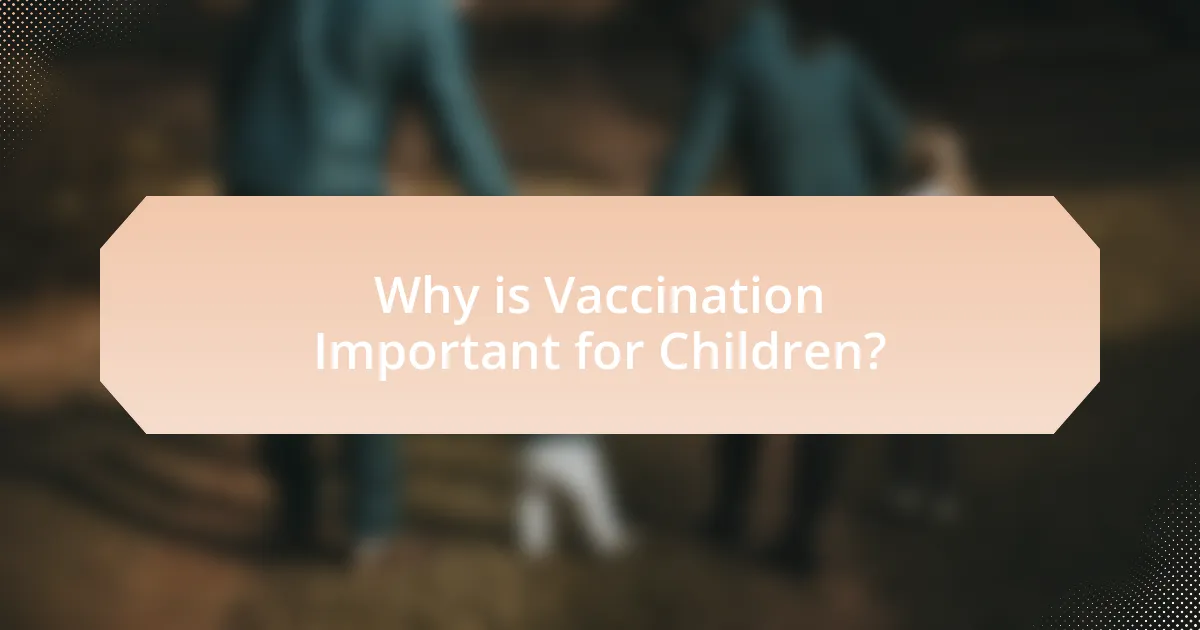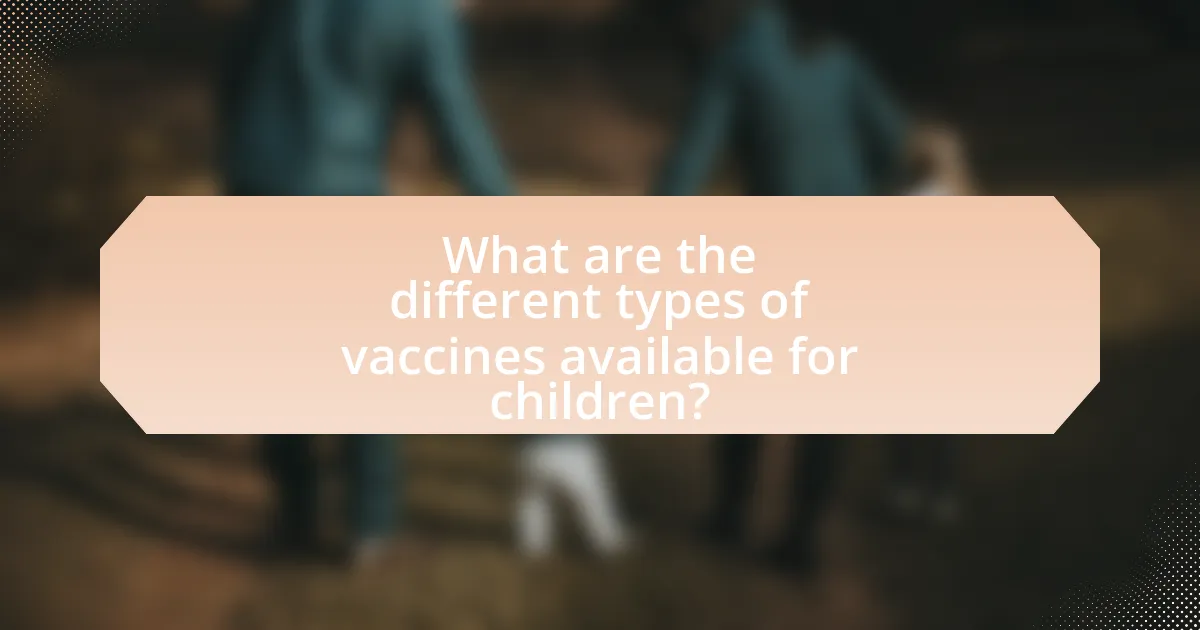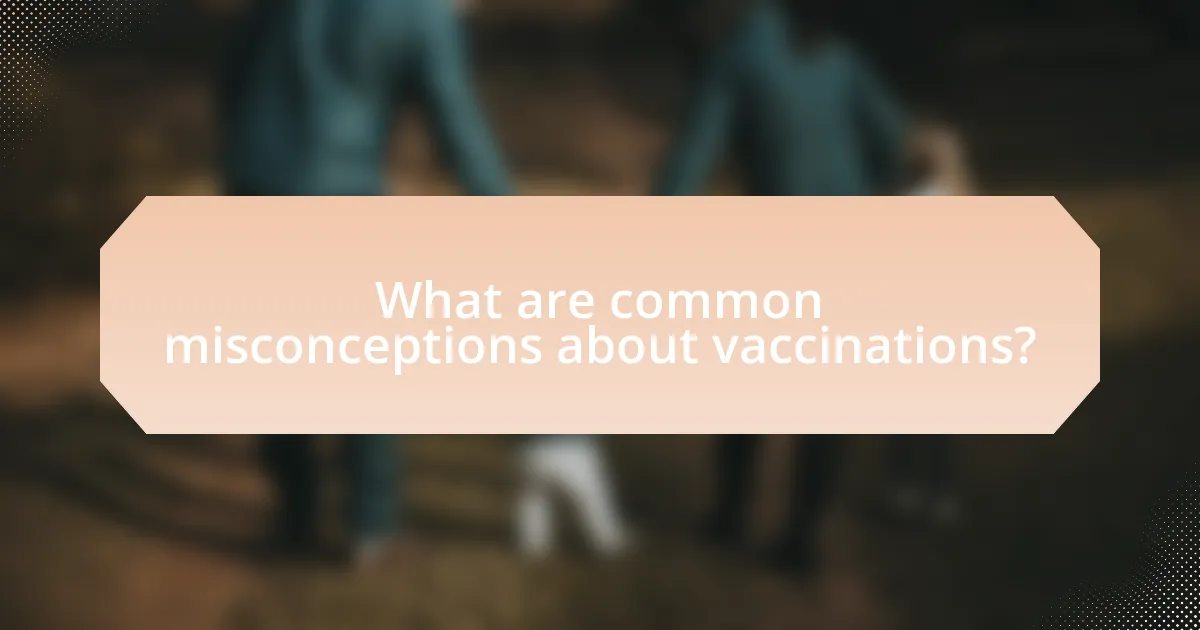Vaccination is a critical public health measure that protects children from serious diseases and reduces mortality rates. This article explores the importance of vaccination for children, detailing the diseases preventable through vaccines, the mechanisms by which vaccines work, and the consequences of not vaccinating. It also discusses the concept of herd immunity, the economic benefits of vaccinations, and the various types of vaccines available. Additionally, the article addresses common misconceptions about vaccines, the role of healthcare providers in vaccination education, and best practices for ensuring children receive their vaccinations on schedule.

Why is Vaccination Important for Children?
Vaccination is important for children because it protects them from serious and potentially life-threatening diseases. Vaccines stimulate the immune system to recognize and fight specific pathogens, significantly reducing the incidence of diseases such as measles, mumps, rubella, and whooping cough. According to the World Health Organization, vaccination prevents an estimated 2-3 million deaths each year among children under five years old. By ensuring high vaccination coverage, communities achieve herd immunity, which protects those who cannot be vaccinated, such as infants and individuals with certain medical conditions.
What diseases can vaccinations prevent in children?
Vaccinations can prevent several diseases in children, including measles, mumps, rubella, polio, diphtheria, tetanus, pertussis (whooping cough), hepatitis A, hepatitis B, and varicella (chickenpox). The Centers for Disease Control and Prevention (CDC) states that vaccines are effective in reducing the incidence of these diseases, which can lead to severe complications or death. For example, the measles vaccine has been shown to be 97% effective in preventing measles after two doses, significantly reducing outbreaks and associated morbidity.
How do vaccines work to protect against these diseases?
Vaccines work by stimulating the immune system to recognize and combat specific pathogens, thereby providing protection against diseases. When a vaccine is administered, it introduces a harmless component of the pathogen, such as a weakened or inactivated virus, or a piece of its genetic material. This exposure prompts the immune system to produce antibodies and memory cells that remain in the body. If the individual later encounters the actual pathogen, the immune system can quickly recognize and respond to it, preventing illness. For example, the measles vaccine has been shown to reduce the incidence of measles by over 90%, demonstrating the effectiveness of vaccination in disease prevention.
What are the consequences of not vaccinating children?
Not vaccinating children leads to increased susceptibility to preventable diseases, resulting in higher rates of illness, hospitalization, and death. For instance, unvaccinated children are at a significantly greater risk of contracting diseases such as measles, mumps, and whooping cough, which can lead to severe complications. The Centers for Disease Control and Prevention (CDC) reported that measles can cause pneumonia, encephalitis, and even death in about 1 in 1,000 cases. Additionally, outbreaks of vaccine-preventable diseases can occur, threatening not only unvaccinated children but also those who cannot be vaccinated due to medical reasons, thereby compromising herd immunity. The World Health Organization (WHO) noted that in 2019, there was a 553% increase in measles cases globally, largely attributed to declining vaccination rates.
How do vaccinations contribute to public health?
Vaccinations contribute to public health by preventing the spread of infectious diseases and reducing morbidity and mortality rates. They achieve this through herd immunity, where a significant portion of the population becomes immune, thereby protecting those who cannot be vaccinated, such as infants and individuals with certain health conditions. For example, the World Health Organization reported that vaccines prevented an estimated 2-3 million deaths annually from diseases like measles and diphtheria. Furthermore, widespread vaccination programs have led to the eradication of smallpox and a significant decline in polio cases globally, demonstrating their critical role in maintaining public health.
What is herd immunity and why is it significant?
Herd immunity is a form of indirect protection from infectious diseases that occurs when a significant portion of a population becomes immune, either through vaccination or previous infections. This immunity reduces the overall amount of the virus or bacteria available to spread, thereby protecting individuals who are not immune, such as those who cannot be vaccinated due to medical reasons.
The significance of herd immunity lies in its ability to prevent outbreaks and protect vulnerable populations, including infants, the elderly, and individuals with compromised immune systems. For example, vaccination programs that achieve herd immunity can lead to the eradication of diseases, as seen with smallpox, which was declared eradicated in 1980 due to widespread vaccination efforts.
How do vaccinations reduce healthcare costs?
Vaccinations reduce healthcare costs by preventing diseases that would otherwise require expensive treatments and hospitalizations. For instance, the Centers for Disease Control and Prevention (CDC) estimates that for every dollar spent on childhood vaccinations, the healthcare system saves approximately $3 in direct costs and up to $10 in total societal costs when considering lost productivity and other factors. By significantly lowering the incidence of vaccine-preventable diseases, vaccinations decrease the burden on healthcare resources, leading to lower overall healthcare expenditures.

What are the different types of vaccines available for children?
The different types of vaccines available for children include inactivated vaccines, live attenuated vaccines, subunit vaccines, conjugate vaccines, and mRNA vaccines. Inactivated vaccines, such as the polio vaccine, contain killed pathogens that cannot cause disease. Live attenuated vaccines, like the measles, mumps, and rubella (MMR) vaccine, use weakened forms of the virus to stimulate an immune response. Subunit vaccines, such as the hepatitis B vaccine, include only parts of the pathogen, which helps the immune system recognize it. Conjugate vaccines, like the Haemophilus influenzae type b (Hib) vaccine, link polysaccharides from the pathogen to proteins to enhance the immune response. Lastly, mRNA vaccines, such as those developed for COVID-19, use messenger RNA to instruct cells to produce a harmless piece of the virus, prompting an immune response. These vaccines are crucial for preventing serious diseases in children and are supported by extensive research and public health guidelines.
What are the standard vaccines recommended for children?
The standard vaccines recommended for children include the DTaP (diphtheria, tetanus, and pertussis), IPV (inactivated poliovirus), MMR (measles, mumps, and rubella), Hib (Haemophilus influenzae type b), PCV (pneumococcal conjugate), and HepB (hepatitis B) vaccines. These vaccines are part of the immunization schedule established by health authorities, such as the Centers for Disease Control and Prevention (CDC), to protect children from serious diseases. For instance, the DTaP vaccine is administered in five doses, starting at two months of age, to prevent diphtheria, tetanus, and pertussis, which can lead to severe health complications.
How is the vaccination schedule determined for children?
The vaccination schedule for children is determined by public health authorities based on extensive research and epidemiological data. These schedules are designed to provide immunity at the optimal age to prevent diseases that can cause significant morbidity and mortality in children. For instance, the Centers for Disease Control and Prevention (CDC) and the World Health Organization (WHO) regularly review scientific evidence regarding vaccine efficacy and safety, leading to recommendations that are updated as new data emerges. This process ensures that the vaccination schedule reflects the latest understanding of disease prevalence and the best timing for immunization to maximize protection.
What are combination vaccines and their benefits?
Combination vaccines are immunizations that protect against multiple diseases with a single injection. These vaccines streamline the vaccination process by reducing the number of shots a child needs, which can enhance compliance and convenience for parents. For example, the MMR vaccine protects against measles, mumps, and rubella, while the DTaP vaccine covers diphtheria, tetanus, and pertussis. The benefits of combination vaccines include improved vaccination rates, reduced healthcare costs, and minimized discomfort for children, as fewer injections lead to less pain and anxiety during visits. Additionally, combination vaccines can help ensure that children receive timely protection against serious diseases, contributing to overall public health by promoting herd immunity.
How do vaccines differ based on age and health conditions?
Vaccines differ based on age and health conditions primarily in their formulation, dosage, and timing of administration. For instance, infants receive vaccines like the DTaP (diphtheria, tetanus, and pertussis) at 2, 4, and 6 months, while older children and adults receive booster doses at different intervals. Additionally, individuals with specific health conditions, such as immunocompromised states, may require inactivated vaccines instead of live attenuated ones to avoid adverse effects. The Centers for Disease Control and Prevention (CDC) provides guidelines that specify these variations, ensuring that vaccination schedules are tailored to optimize safety and efficacy for different age groups and health statuses.
What special considerations are there for immunocompromised children?
Immunocompromised children require special considerations regarding vaccination to ensure their safety and health. These children may have weakened immune systems due to conditions such as cancer, HIV, or genetic disorders, making them more susceptible to infections. Vaccination schedules may need to be adjusted, and live vaccines are often contraindicated due to the risk of causing disease in these vulnerable populations. The Centers for Disease Control and Prevention (CDC) recommends that immunocompromised children receive inactivated vaccines and may require additional doses to achieve adequate immunity. Regular consultations with healthcare providers are essential to tailor vaccination plans that consider the child’s specific medical condition and treatment regimen.
How do travel vaccines differ from routine vaccines?
Travel vaccines differ from routine vaccines primarily in their targeted purpose and the specific diseases they protect against. While routine vaccines are designed to provide immunity against common infectious diseases prevalent in a specific region, travel vaccines are tailored to protect against diseases that are more likely to be encountered in specific geographic areas, particularly those that are endemic or have outbreaks. For instance, routine vaccines include those for measles, mumps, and rubella, which are standard in childhood immunization schedules, whereas travel vaccines may include immunizations for diseases like yellow fever or typhoid fever, which are not typically encountered in many developed countries. This distinction is crucial for ensuring that travelers are adequately protected based on their destination and potential exposure risks.

What are common misconceptions about vaccinations?
Common misconceptions about vaccinations include the belief that vaccines cause autism, that natural infection is better than vaccination, and that vaccines contain harmful levels of toxins. Research published in the journal “Annals of Internal Medicine” by Taylor et al. (2014) found no causal link between vaccines and autism, debunking this myth. Additionally, the World Health Organization states that vaccines provide safe and effective immunity without the risks associated with natural infections, which can lead to severe complications. Lastly, the Centers for Disease Control and Prevention (CDC) confirms that vaccine ingredients are present in amounts that are safe and effective, countering the notion that vaccines are toxic.
Why do some parents hesitate to vaccinate their children?
Some parents hesitate to vaccinate their children due to concerns about vaccine safety and potential side effects. Research indicates that misinformation about vaccines, particularly regarding their links to autism and other health issues, contributes significantly to this hesitation. For instance, a study published in the journal “Vaccine” found that 30% of parents expressed concerns about vaccine safety, often influenced by anecdotal reports and social media narratives. Additionally, some parents may have philosophical or religious beliefs that oppose vaccination, further complicating their decision-making process.
What myths about vaccines are prevalent in society?
Prevalent myths about vaccines include the belief that vaccines cause autism, that natural immunity is better than vaccine-acquired immunity, and that vaccines contain harmful levels of toxins. The claim linking vaccines to autism originated from a discredited study published in 1998 by Andrew Wakefield, which has been thoroughly debunked by extensive research, including a 2014 study published in the Annals of Internal Medicine that found no association between vaccines and autism. The notion that natural immunity is superior overlooks the fact that vaccines provide safe and effective immunity without the risks associated with the diseases they prevent. Additionally, vaccines do contain preservatives and adjuvants, but these are present in amounts deemed safe by health authorities, such as the CDC and WHO, which have established guidelines based on extensive scientific evidence.
How can accurate information help combat vaccine hesitancy?
Accurate information can significantly combat vaccine hesitancy by addressing misconceptions and providing evidence-based data that reinforces the safety and efficacy of vaccines. When individuals receive clear, factual information about vaccine benefits, such as the reduction of disease incidence and the protection of community health, they are more likely to trust and accept vaccinations. For instance, studies have shown that misinformation can lead to increased hesitancy; a 2021 survey by the Kaiser Family Foundation found that 80% of unvaccinated adults cited misinformation as a key reason for their hesitancy. By countering this misinformation with accurate data, public health campaigns can effectively reduce fears and increase vaccination rates among children, ultimately leading to better public health outcomes.
What role do healthcare providers play in vaccination education?
Healthcare providers play a crucial role in vaccination education by delivering accurate information, addressing concerns, and promoting vaccine acceptance among patients. They serve as trusted sources of knowledge, helping to dispel myths and misinformation about vaccines. Studies show that when healthcare providers actively engage in discussions about vaccination, vaccination rates increase significantly; for instance, a study published in the journal “Pediatrics” found that provider recommendations are one of the strongest predictors of vaccination uptake. By providing evidence-based information and personalized counseling, healthcare providers enhance public understanding of the benefits and safety of vaccines, ultimately contributing to higher immunization rates and better public health outcomes.
How can providers effectively communicate the importance of vaccines?
Providers can effectively communicate the importance of vaccines by utilizing clear, evidence-based messaging that emphasizes the benefits of vaccination for individual and public health. For instance, studies show that vaccines prevent approximately 2-3 million deaths each year from diseases like measles and diphtheria, highlighting their critical role in disease prevention. Additionally, providers should engage in open dialogues, addressing concerns and misconceptions while providing factual information about vaccine safety and efficacy. This approach fosters trust and encourages informed decision-making among parents regarding their children’s health.
What resources are available for parents seeking vaccination information?
Parents seeking vaccination information can access several reliable resources, including the Centers for Disease Control and Prevention (CDC) website, which provides comprehensive guidelines on vaccines, schedules, and safety information. Additionally, the American Academy of Pediatrics (AAP) offers resources specifically tailored for parents, including articles and FAQs about childhood vaccinations. The World Health Organization (WHO) also provides global vaccination data and recommendations that can help parents understand the importance of immunization. These organizations are recognized for their expertise and authority in public health, ensuring that the information is accurate and up-to-date.
What are best practices for ensuring children receive their vaccinations?
Best practices for ensuring children receive their vaccinations include maintaining a consistent vaccination schedule, educating parents about the importance of vaccines, and utilizing reminder systems. Consistent vaccination schedules, as recommended by the Centers for Disease Control and Prevention (CDC), help ensure that children receive vaccines at the appropriate ages, which is crucial for effective immunity. Educating parents about vaccine benefits and addressing concerns can increase acceptance; studies show that informed parents are more likely to vaccinate their children. Additionally, reminder systems, such as text messages or phone calls from healthcare providers, have been shown to improve vaccination rates by prompting parents to schedule appointments.